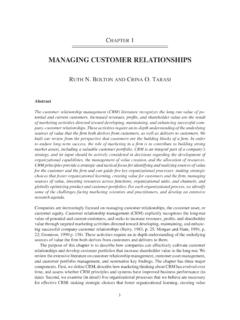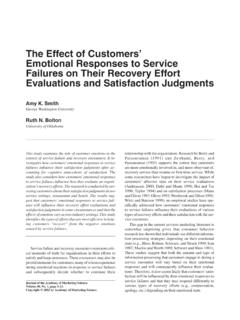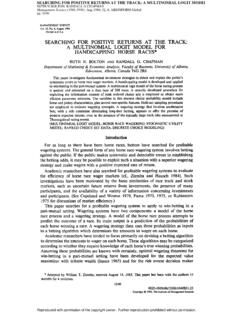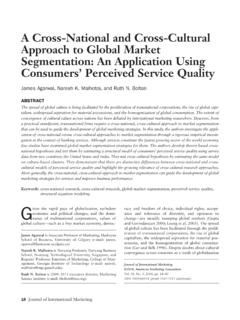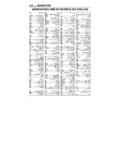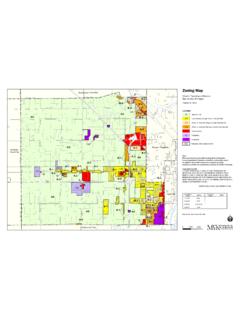Transcription of Crina O. Tarasi, Ruth N. Bolton, Michael D. Hutt, & …
1 Crina O. Tarasi, Ruth N. Bolton, Michael D. Hutt, & Beth A. WalkerBalancing Risk and return in aCustomer PortfolioMarketing managers can increase shareholder value by structuring a customer portfolio to reduce the vulnerabilityand volatility of cash flows. This article demonstrates how financial portfolio theory provides an organizingframework for (1) diagnosing the variability in a customer portfolio , (2) assessing the complementarity/similarity ofmarket segments, (3) exploring market segment weights in an optimized portfolio , and (4) isolating the reward onvariability that individual customers or segments provide. Using a seven-year series of customer data from a largebusiness-to-business firm, the authors demonstrate how market segments can be characterized in terms of riskand return . Next, they identify the firm s efficient portfolio and test it against (1) its current portfolio and (2) ahypothetical profit maximization portfolio .
2 Then, using forward- and back-testing, the authors show that the efficientportfolio has consistently lower variability than the existing customer mix and the profit maximization portfolio . Theauthors provide guidelines for incorporating a risk overlay into established customer management frameworks. Theapproach is especially well suited for business-to-business firms that serve market segments drawn from diversesectors of the : customer portfolio management, market-based assets, financial portfolio theory, return on marketing,market segmentationCrina O. Tarasi is Assistant Professor of Marketing, Central Michigan Uni-versity (e-mail: Ruth N. Bolton is 2009 2011 Executive Director, Marketing Science Institute (e-mail: D. Hutt is Ford Motor Company Distinguished Professor of Market-ing (e-mail: and Beth A.)))
3 Walker is State Farm Pro-fessor of Marketing (e-mail: Carey School ofBusiness, Arizona State University. The authors acknowledge the supportof the Marketing Science Institute and are grateful to the managers at thesponsor firm for their responsive support and high level of authors thank Don Lehmann, Kay Lemon, and Michael Mokwa fortheir valuable comments. In addition, the authors thank the three anony-mous JMreviewers for their incisive comments and useful suggestions. 2011, American Marketing AssociationISSN: 0022-2429 (print), 1547-7185 (electronic)Journal of MarketingVol. 75 (May 2011), 1 171 The advantage of knowing about risks is that we canchange our behavior to avoid Optimal behaviortakes risks that are worthwhile. (Engle 2004, p. 405)Although risk management is central to financial port-folio theory and occupies much of chief financialofficers time, researchers have given sparse atten-tion to risk in the theory and practice of market segmenta-tion and customer portfolio management.)
4 The existing port-folio of most firms reflects incremental and uncoordinateddecisions from the past, when they gave little attention tohow newly acquired customers contributed to the profitabil-ity and risk of the entire portfolio . For example, Homburg,Steiner, and Totzek (2009) find that firms tend to overesti-mate the value of top-tier customers and underestimate thatof bottom-tier customers. In a similar vein, Dhar and Glazer(2003, p. 88) observe that few companies consider whetherall of their individually desirable customers are, from thestandpoint of risk, desirable collectively. This practice is atodds with financial portfolio theory, which posits thatalthough assets are selected individually, performance ismeasured on the entire portfolio , in which there is a trade-off between risk and return (Markowitz 1952).
5 We theorizethat, like a financial portfolio , a customer portfolio is formedby making choices among market-based assets ( , cus-tomers) that present different risk reward characteristicsand allocating resources to optimize performance (Guptaand Lehmann 2005; Srivastava, Shervani, and Fahey 1998).The purpose of our research is to explore how financialprinciples of diversification and the tenets of financial port-folio theory can be effectively applied to manage a firm scustomer portfolio . We demonstrate how fundamental toolsof analysis that professional investors use in constructingand managing a stock portfolio can be adapted and used toenrich a firm s market segmentation and customer portfoliodecisions. First, we aim to identify risk that can (and should)be divested away because firms do not reap greater returnsfrom assuming it and (instead) suffer losses when marketconditions change.
6 Second, we attempt to identify ways toconstruct efficient customer portfolios. Third, we build onthese components to develop an actionable approach that,by looking beyond the returns from individual customers,exploits the synergies of a diverse customer base character-ized by heterogeneous risk return profiles and provides anew approach for managing a firm s market-based and Smith s (1983) initial application of finan-cial portfolio theory to product portfolio decisions spawnedcriticism from Devinney, Stewart, and Shocker (1985), whoidentify key differences between financial and productinvestment decisions, arguing that crucial assumptions ofthe theory were violated (see Cardozo and Smith s [1985]reply). However, recent research has demonstrated thepotential insights that financial portfolio theory can con-tribute to customer portfolio management.
7 Dhar and Glazer(2003) describe the importance of measuring the riskinessof customers ( , customer beta) and illustrate how a firmcan maximize returns by acquiring or retaining particularcustomers or market segments on the basis of how theirspending patterns contribute to the diversification of thecash flow of the overall customer (2002, 2003) also adopts a financial theory per-spective to examine the risk and return characteristics of acustomer portfolio and describe how a customer relationshipscorecard can be used to assess customer risk. Likewise,Buhl and Heinrich (2008) offer a quantitative model basedon financial portfolio theory that (1) considers the customerlifetime value (CLV) in addition to the associated risks ofcustomer segments and (2) provides a method for adding andsubtracting market segments. Using a case study from thefinancial services industry, they test the model by using theaverage annual incomes of key customer segments ( ,lawyers, physicians) as an indicator of cash flows and demon-strate how the optimal portfolio provides both higher utilityand better risk diversification than the existing study makes the following contributions to customerportfolio theory and practice: First, we build on past researchto show theoretically and empirically how to make a nuancedassessment of customer value by calculating the customerbeta (Buhl and Heinrich 2008; Dhar and Glazer 2003) andcontribute a new metric for customer portfolio management:the customer reward ratio.
8 customer beta provides a relativemeasure of the sensitivity of an individual customer s cashflow return to that of the firm s current customer adjusting for variability, the customer reward ratio,drawn from Sharpe s (1994) work, takes into account therisk reward trade-off associated with the , the study evaluates the extent to which classicmarket segmentation variables ( , demographics, firmo-graphics) can be used to predict cash flow characteristics( , risk return profiles) of customers so that managers canassess how potential (and existing) customers might con-tribute to the customer portfolio . Note that unlike some priorresearch that controls for customer heterogeneity (Niraj,Gupta, and Narasimhan 2001; Venkatesan and Kumar2004), our approach evaluates and exploits customerheterogeneity to improve business , the current study is responsive to calls forresearch that examines the financial impact of customerportfolio management decisions ( , Rust et al.)
9 2004). Weshow conceptually and empirically how a firm can identifysynergies among customers and assemble the optimal mixof customers by constructing an efficient frontier for cus-tomer portfolios. The efficient frontier describes alternativeoptimal customer portfolios those characterized by mini-mum risk for a certain level of return or maximum returnfor a certain level of risk. Finally, Tuli, Bharadwaj, andKohli (2010) provide evidence that the number and types ofties a company builds with its best customers not onlyensures higher revenue but also reduces the variability oftheir purchases. We extend their work by demonstrating thatthe firm can manage its portfolio of customer relationshipsto control the overall variability of its cash test the feasibility of applying key financial con-cepts to customer portfolios by implementing them using a2 / Journal of Marketing, May 2011seven-year series of customer data from a large business-to-business company.
10 We begin by exploring whether we cansegment the firm s customer base in ways that are compara-ble with financial asset classification. Then, we identify thefirm s efficient customer portfolio and test it against (1) itscurrent portfolio and (2) a hypothetical profit-optimizationportfolio. Our results show that customers exhibit substan-tial differences in their risk return profiles and that cluster-ing techniques can be used to identify market segments forbuilding efficient portfolios. Most important, we demon-strate that the firm s efficient portfolio has constantly lowervariability than the existing customer mix and the profitmaximization portfolio and that its profit performance issuperior in the long FrameworkThis section reviews financial portfolio theory and concep-tualizes how key financial constructs can be applied to cus-tomer portfolios.


